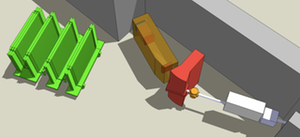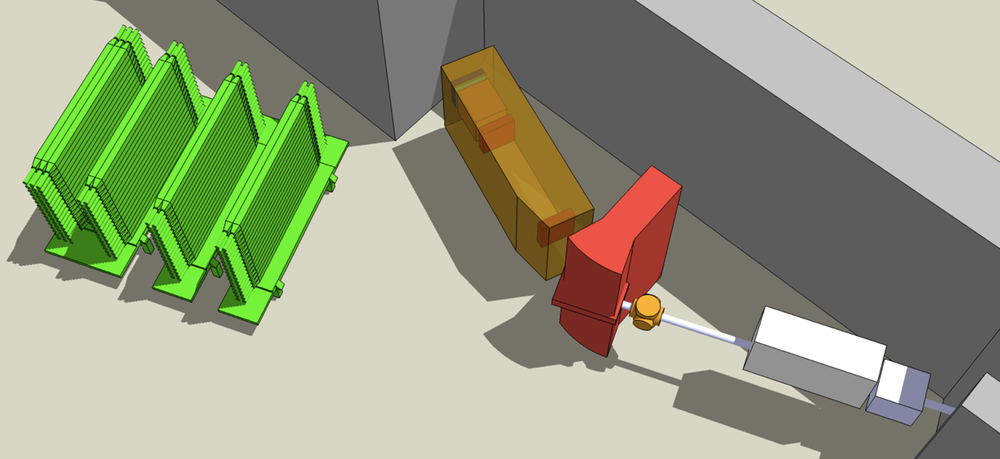Nuclei Emit Paired-up Neutrons
A neutron-only nucleus is considered physically impossible, but researchers have now seen a short-lived neutron pairing as a product of nuclear decay. The so-called dineutron had been indirectly observed inside neutron-rich nuclei, but the new experimental evidence reported in Physical Review Letters confirms that pairs of neutrons can exist outside the nucleus, albeit for a very short time. Further dineutron research could provide insight into the nuclear physics of neutron stars and supernovae.
The forces holding together the protons and neutrons in a nucleus are not completely understood. Exotic forms of matter, such as dineutrons and diprotons, offer researchers the chance to push their models to extremes and see how well they hold up. Both dineutrons and diprotons are nearly stable, so researchers have searched for brief appearances of thses particle pairs in nuclear reactions for several decades. Most of these searches have looked for diprotons because neutron-rich nuclei are harder to make, and neutrons are harder to detect. The results have been ambiguous, in part because the electric charge on the proton complicates the data analysis.
Recent experiments with the neutron-rich isotopes helium- and helium- have given indications that the “valence” neutrons—which orbit outside the central core of the nucleus—pair up as a dineutron . But generating dineutrons as decay products outside of a nucleus would provide a much more direct way to study them. Researchers have looked for dineutrons in two-neutron decays from neutron-rich nuclei, such as hydrogen- and helium- , but these nuclei usually generate successive decays of one neutron followed by another, rather than a combined pair.
“Usually if a nucleus can emit a single neutron, then it will just do that,” explains Artemis Spyrou of Michigan State University (MSU) in East Lansing. She and her colleagues have solved this problem by identifying a nucleus, beryllium- , in which two-neutron decay is favored. Single-neutron decay is unlikely because the resulting nucleus, beryllium- , is even more unstable than beryllium- with respect to neutron emission.
There is no direct path to generate beryllium- from any stable nucleus, so the team chose an unstable nucleus, boron- , that could act as an intermediate “stepping stone.” Working at the National Superconducting Cyclotron Laboratory at MSU, they isolated boron- from other products coming out of collisions between a high-energy neon beam and a beryllium- target. They then directed this secondary boron beam at another beryllium- target. The resulting collisions occasionally knocked a proton out of a boron nucleus, producing neutron-rich beryllium- .
Beryllium- decays in about seconds into beryllium- and two neutrons, and all three decay products had to be measured. Detecting and identifying beryllium- wasn’t difficult, but tagging the two neutrons was harder, because single neutrons occasionally generated two flashes in the detector array. To be sure they were seeing two neutrons, Spyrou’s team rejected any pairs of flashes that occurred within centimeters of each other.
For the selected events, the researchers measured the energies and scattering angles for the beryllium- and the two neutrons. They compared the data with computer simulations for three possible scenarios. The first was two consecutive, single-neutron decays. The second was three-body decay, in which the two neutrons are emitted at the same time but without any spatial correlation with each other. The final scenario involved two neutrons clustered together as a dineutron, which falls apart in about seconds. The best match to the data was the dineutron decay model.
“This is a really fine experiment,” says Bertram Blank of the Center for Nuclear Studies in Bordeaux-Gradignan (CENBG), France. He believes the dineutron is a handy way to describe the data, but the real state of the neutrons may be more complex. Witold Nazarewicz of the University of Tennessee in Knoxville believes this is a significant experimental finding, since it supports other work suggesting that neutrons couple together in pairs the way electrons do in superconductors. As more data are collected on dineutrons, Nazarewicz expects we may gain insights into other neutron-rich matter, such as neutron stars and neutron-rich outflows in supernovae, where heavy nuclei are synthesized.
–Michael Schirber
Michael Schirber is a Corresponding Editor for Physics Magazine based in Lyon, France.
References
- P. Mueller et al., “Nuclear Charge Radius of ⁸He,” Phys. Rev. Lett. 99, 252501 (2007)
More Information
A Super Mix Inside Neutron Stars (Focus, 2008)
A stellar superfluid (Viewpoint, 2011)
Can a nucleus be made up of neutrons only? (CNRS press release, 2002)
S. C. Pieper, “Can Modern Nuclear Hamiltonians Tolerate a Bound Tetraneutron?” Phys. Rev. Lett. 90, 252501 (2003) (theory paper challenging the idea of a 4-neutron particle)





